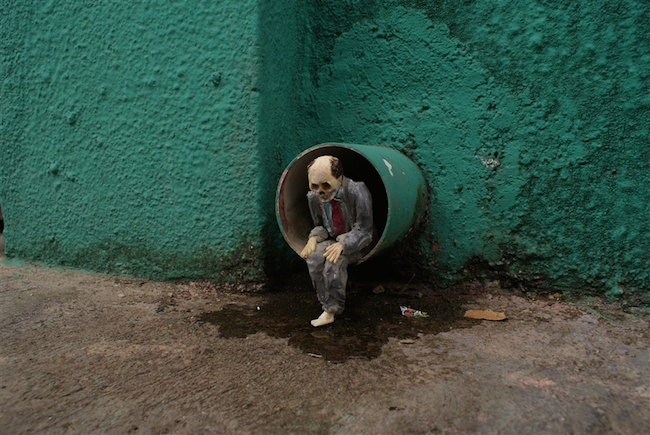Artist Isaac Cordal creates miniature works in cement. Posed within actual urban environments, his figures tell stories of isolation, loneliness and creeping age.
Though they’re not clay, the miniature is a favored form within ceramics. We’re reminded in particular of the work of Josianne Keller, who approached similar themes with her work about homeless children. As with Keller, Cordal’s sculptures are touching in a sad way. Rather than despair, they awake in us a desire to help the people around us who are sick under the gradual decay of entropy. It’s an empathy born out of a warning— these figures could be ourselves.


Cordal states:
“Men and women are suspended and isolated in a motion or pose that can take on multiple meanings. The sympathetic figures are easy to relate to and to laugh with. They present fragments in which the nature, still present, maintains encouraging symptoms of survival. The precariousness of these anonymous statuettes, at the height of the sole of the passers, represents the nomadic remainders of an imperfect construction of our society. These small sculptures contemplate the demolition and reconstruction of everything around us. They catch the attention of the absurdity of our existence.”


Isaac Cordal, Sasiedzi
One of his latest works was installed on the streets of Lodz, Poland. Sasiedzi (“Neighbors,” in Polish) shows figures caged within balconies. They’re posed at angles, never directly facing each other. Several have their noses stuck in their cell phones. Hot takes about the irony of cell phones both connecting and alienating people are dangerously close to being a cliché at this point, but Sasiedzi offers a window into the rest of Cordal’s work.
Writing for DesignBoom, Nina Azzarello states:
“the installation presented for the lodz 4 cultures festival sees a grid of cage-like balconies attached to a building façade. within the units, single miniature figures are trapped, some intently staring at their phones and making calls, others vacantly staring at each other from an inaccessible distance. ‘never before have we been so connected one to the other yet at the same time being so isolated’, cordal continues.”
I’ve listened to what seems like dozens of sermons from people shaking their heads at society’s addiction to cell phones, so the message comes off as a little trite. I’m more drawn to Cordal’s broader existential themes. I haven’t felt disconnected or drugged by my cell phone, but I definitely have at times felt like one of his figures submerged in a dirty puddle on the sidewalk while people walk past. That image clarifies an experience that many people have, but struggle to articulate. His skeletons that haunt rusted drainpipes or grates read like a warning, an expression of the fear that I could end up in such a place when I’m older.


The way out, if there is one, is communicated by the scale of the figures. Their size is dwarfed by the monstrous urban landscapes they inhabit, but it also gives the viewer the opportunity to rescue them. The feeling of empathy they create make me want to lift them from their lonely environment and take them out for a beer. We all have this power, should we see one of these figures in real life. All they need is for someone to recognize their dilemma and make a connection with them. Show these figures a little tenderness and maybe someone will do the same for you, should you ever find yourself in their place.
Bill Rodgers is a Contributing Editor at CFile.
Any thoughts about this post? Share yours in the comment box below.










Never have seen miniatures in cement before, a great talent! Sad figures but great placements, afraid he’s got a good grasp of society! Love my cell phone but hate what is doing to our society!!!